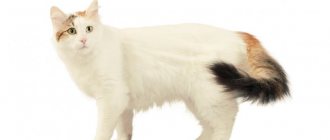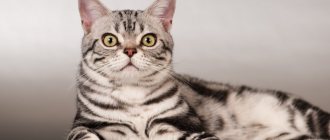The name of the Seychelles cat breed comes from the name of the Seychelles Islands in the Indian Ocean. It is generally accepted that it was from these islands that the cat came to Great Britain in the mid-80s of the last century.
Let the legend remain a beautiful fairy tale, but the reality is that most experts do not recognize these cats as a separate breed. They motivate this by the fact that Seychelles are very similar to Oriental, Balinese and Siamese cats. Whatever it is, Seychelles cats definitely feel very special. Apparently it has to do with the national character of the breed.
- 3.1 Care
Origin story
It would seem: the name speaks for itself - where can Seychelles cats come from, if not from any of the Seychelles islands?
However, this is not quite true. What do the facts say? It is unknown exactly when cats were brought to the Seychelles. One thing is for sure: they lived there for many years, adapting to extremely high temperatures and humidity. This is evidenced by the absence of a fat layer, thick hair and the presence of “burdock” ears.
In 1980, several individuals were exported to the UK by felinologists: in Foggy Albion they had long wanted to breed a new breed. Serious work has been carried out on crossing overseas guests with Persian, Siamese, Oriental and other oriental cats, but, despite the established standard, the breed still has the status of “experimental”.
Despite the fact that the breed is not officially recognized, it is very popular both in Russia and abroad. There are nurseries in the CIS countries, Germany, the USA and Australia.
Maintenance, care, health
As for grooming, it is minimal. The fur needs to be brushed quite rarely. Once a week will be more than enough. You need to bathe your cat as needed. And given that the Seychelles are not fans of street walks, it is unlikely that water procedures will be necessary more than once a month.
Once a week you need to conduct a thorough examination of the animal. It is necessary to palpate the tummy, examine the ears and eyes, and, if necessary, remove wax.
Although the Seychelles are famous for their excellent health, a preventative visit to the veterinarian will not be superfluous. Such trips should be organized once a quarter.
Standards
Seychelles cats are often confused with Orientals: they are also graceful, with the same thin bones and long legs. They weigh a little: 2-4 kg.
| Standard | Description |
| Head | Strongly elongated, triangular in shape, with a sharp chin and flat cheekbones. The bridge of the nose is narrow, straight, the ears are large, set wide, with rounded tips. |
| Eyes | Open, almond-shaped. The color of the iris is all shades of blue and blue. |
| Torso | Elongated, lean, fit, with strong muscles. The neck is long and thin, the back is flat and narrow, and the chest is also not wide. |
| Limbs | Thin, small paws, thin, toned fingers. The claws are long but thin. |
| Tail | Thin, like a whip, long, set low. |
| Wool | Seychelles cats can have very short or medium-length fur. Short-haired individuals have a sparse and soft undercoat, while short-haired individuals have no undercoat. |
When choosing a kitten, pay attention to both appearance and behavior. The baby should not have scratching or wax plugs in the ears, discharge from the eyes or nose, cough, or bad breath. A clean butt and smooth, elastic tummy, shiny fur without bald spots are another indicator of health. A healthy toddler behaves lively and active: he plays with his brothers and sisters, runs after lumps of paper, and is not afraid of human hands and voices. Be sure to pay attention to the behavior of the kitten’s mom and dad: if the parents are aggressive or intimidated, their offspring will most likely be the same.
How to choose a kitten
Experts recommend paying attention to the following points when choosing a Seychelles:
- The eyes and nose should be completely clean, without any discharge.
- The ears are free of discharge and not combed.
- There should also be no discharge from the anus.
- Six is soft, clean and fluffy.
- The abdomen is not swollen or sunken.
- The animal does not cough or itch.
Typically, breeders sell kittens from 4 months of age, already fully socialized and litter box trained. When purchasing a white kitten, be prepared for the fact that the color will change with age.
Colors
There are 3 types:
- Septieme – white fur with small spots on the head and paws (motley tail);
- Huitieme – white coat color, motley tail, large spots on the skin;
- Neuvieme - the main color is white, the spots on the skin are red, gray, black.
The cute mask that Seychelles cats have should not occupy the entire head.
Seychelles kittens are born white as snow, and their distinctive color is formed only by 2.5-3 years.
In the photo there is a Seychelles cat of popular colors
Seychelles cat
The name of the Seychelles cat breed comes from the name of the Seychelles Islands in the Indian Ocean. It is generally accepted that it was from these islands that the cat came to Great Britain in the mid-80s of the last century.
Let the legend remain a beautiful fairy tale, but the reality is that most experts do not recognize these cats as a separate breed. They motivate this by the fact that Seychelles are very similar to Oriental, Balinese and Siamese cats. Whatever it is, Seychelles cats definitely feel very special. Apparently it has to do with the national character of the breed.
Character and behavior
The Seychelles cat is truly a regal person. As soon as she appears in your house, you will immediately understand: it was not you who settled her - it was she herself who came to you and graciously decided to make you happy. This cat will not allow itself to be disrespected even by the person it loves very much. You can’t raise your voice at her, much less raise your hand—her touchiness knows no bounds. And how to take revenge - the Seychelles cat knows literally from the cradle. Therefore, if you absolutely cannot do without punishment, use a spray bottle: it is both effective and not so offensive.
With other pets, the Seychelles cat will behave in the same way as with humans: regal and even defiant, thereby trying to make it clear who is the leader of the pack.
With cats of more flexible breeds, this trick may work, but the same restless ones will quickly show the Seychellois that they are not the ones who “turn the globe.” It definitely won't happen without a fight! Jealousy is also mixed in with everything: if a cat notices that the owner is spending more time on another pet, he will start playing dirty tricks on both.
The same thing can happen with dogs. And various small animals such as ornamental rats, dwarfs and canaries will not feel safe even in a cage. Seychelles cats will try to get to them constantly.
But don’t think that Seychelles has no positive qualities! Representatives of this breed are great with children: children are allowed to do things that adults are not allowed to do. Seychelles will never allow herself to scare or scratch a child. Even if the little one hurts him, the cat will break free from his hands and simply climb higher: to where he cannot be reached. But, having calmed down, he will return to the game again.
Name the cat who always wanted to live together
BasilioLeopold
Seychelles are not afraid of strangers in the house and are very friendly towards them: they boldly approach, sniff, and look at them.
They love comfortable conditions: if they think that the tray smells bad, the filler is too small, and the sides are uncomfortable, they will refuse to go there. At the same time, he will not tolerate it. The result is clear. Therefore, try to clean the cat litter box on time and choose the most comfortable litter.
They have difficulty getting used to a change of place and new living conditions, and do not tolerate trips (even short ones). They also cannot tolerate loneliness and can become seriously ill. Talkers, and the voice of a Seychelles cat can hardly be called pleasant: you will have to get used to its grinding.
You can buy a Seychelles kitten either in a nursery (there are several in Russia) or from a private breeder. The owner of the animals must provide you with a pedigree, a veterinary passport (which contains notes on vaccinations and other medical procedures), a purchase and sale agreement, a document with his personal data, and also explain in detail how to care for the animal and where to go if any problems arise. or problems. The price starts from 10 thousand rubles (pet class specimens, i.e. not participating in exhibitions) and ends at around 30,000 rubles.
Care instructions
Wool
Seychelles cats belong to that small group of cats that do not require brushing at all. Just wet your hands in water and stroke your pet from head to tail: excess fur will stick to your palms, and you can easily remove it.
Eyes
But you need to wipe your eyes and ears. Eyes - daily, soaking a cotton swab in fresh tea leaves, chamomile infusion or chlorhexidine. The ears are cleaned with cotton swabs soaked in a special ear lotion or the same chlorhexidine.
Bathing
Bathing is tolerant, but make sure that water does not get into your ears: liquid can cause otitis media.
Expert opinion
Dusheba Vera Ivanovna
In 2010, she graduated from the Moscow State Academy of Veterinary Medicine named after K.I. Scriabin with honors, specializing in veterinary medicine. I regularly attend veterinary conferences, congresses, and webinars.
You should not wash your cat with your favorite shampoo, even if it smells delicious. And not all children's ones are suitable. If you do not have the opportunity to buy a special detergent, buy baby shampoo without dyes and hypoallergenic.
Claws
The Seychelles cat quite successfully grinds its claws off on its own. Buy her a stable scratching post - that will be enough.
For sleeping, it is best to buy a closed house on a stand: there the cat will feel safe and relax after playing. Remember: Seychelles cats are heat-loving animals, you should not let them freeze, otherwise they will catch a cold.
Catering
Seychelles cats do not require special nutrition: they have fairly strong stomachs and good digestion. However, this does not mean that they can be fed with just anything. Unfortunately, there are many misconceptions about this.
For example, many owners sincerely do not understand why they cannot share fried potatoes or a piece of chocolate with their Murzik. But such food is deadly! Let's look at the basic rules of feeding.
- Food should be balanced and easy to digest. You should not give your animal foods that contain artificial colors and preservatives, salt and sugar. Spicy, fatty, fried, salty, sweet, smoked - all this leads to disruptions in the gastrointestinal tract and diseases in the future.
- Eating 2 times a day: morning and evening. There are exceptions to this rule: some active breeds eat 3 times, and the number of feedings is also increased for pregnant and lactating cats, animals weakened after illness, and the elderly.
- The water is clean and at a comfortable temperature. You should not give tap water: it may contain a lot of bleach, salt and iron, which is dangerous for the animal. Leave the liquid in an open container (12-15 hours), purify it using a special filter or buy bottled water.
Natural products
The diet should contain the following products:
- Fresh meat (beef, rabbit, veal, turkey, lamb) and offal (liver, hearts, stomachs, necks, cartilage). They are given daily in stewed, boiled or raw form (the meat should first be deep-frozen for a day or two, and doused with boiling water before feeding).
- Porridge (oatmeal, buckwheat, millet, barley, pearl barley, rice): given every other day. Boil in water (add milk for babies) without spices and seasonings, but before serving add a teaspoon of vegetable oil (olive, flaxseed, sunflower).
- Fish (flounder, hake, halibut, salmon, trout, navaga): given raw or boiled (but too few useful elements are retained in boiled fish). You should not give fish more than once a week, so as not to provoke urolithiasis (males especially often suffer from this disease).
- Boiled chicken eggs (yolk), boiled quail eggs (whole).
- Vegetables (pumpkin, zucchini, beets, carrots, asparagus, broccoli, green salad, green peas, herbs) are stewed or boiled, mixed with porridge or added to cutlets.
- Dairy products (hard unsalted cheese, natural yogurt, cream, sour cream, yogurt, fermented baked milk, Varenets, kefir) are given 3-4 times a week.
- Fruits and berries (apples, pears, melon, watermelon, cranberries, cloudberries, lingonberries) are given fresh.
Spayed and neutered animals are often prone to obesity. The reason is simple – they move less. Therefore, a special menu is prepared for them, as is the food.
It is prohibited to give:
- Products containing cocoa beans.
- Alcoholic drinks.
- Coffee, tea, juices, compotes.
- Tomatoes, potatoes, eggplants, onions, avocado, garlic.
- Sorrel, rhubarb, fruit seeds.
- Bones (both raw and cooked).
- Grapes, raisins, persimmons, citrus fruits.
It is not advisable to give:
- Legumes.
- Baking and flour.
- Whole cow's milk.
- Pork and goose meat, duck, lard, tripe, raw eggs.
- Dog food.
- Human vitamins with iron in the composition.
- Raw liver.
- Condensed milk and baby formula.
Recommended food
Regarding industrial food, breeders agree on one thing: it is better not to feed Seychelles cats on such food. But if it so happens that you cannot cook for your pet every day, you can use commercial food of the highest quality.
Below are the recommended holistic class foods. Links with the names of the food are clickable, on them you can, within our website, get acquainted with the descriptions of the food and read reviews from owners of Seychelles cats.
| Holistic | Holistic | Holistic |
| Pronature Holistic | Gina Elite | AATU |
Rules of care and feeding
Seychelles cats are easy to care for.
Care
Due to the absence of undercoat, their coat is easy to comb and does not get tangled into clumps. At the same time, they need the attention of their owner, so it is recommended to brush them at least 2 times a week.
During the molting period, the combing procedure should be increased. Representatives of this breed need to be bathed as needed. After brushing, rinse your pet's eyes and clean his ears.
Make sure your pet has a soft, comfortable place to sleep and rest. You will also need to purchase the following set of cat needs:
- scratching post;
- litter tray;
- bowl for water, food;
- climbing device.
Regarding the last point. Specialized stores sell a good selection of devices that the Seychelles cat will happily climb. But with no less success, you can come up with something yourself.
I think scratched furniture and shabby corners of the sofa make few people happy. Therefore, in addition to a scratching post, it is advisable to purchase a nail clipper and periodically (once every two weeks) trim the animal’s claws. If you do not want or do not want to get involved with this procedure, contact professionals. You can always find people providing such services.
Nutrition
Regarding nutrition, this breed requires a balanced and varied diet. They like fermented milk products such as kefir, sour cream, and cottage cheese. They do not refuse raw meat either.
Remember, cats need to cut their meat finely. The most suitable type of meat is chicken and chicken giblets.
Ordinary kitekat is not suitable for them as dry food - for them it is better to buy premium or super-premium food. Also, do not forget that your pet should always have water in his bowl. Change it at least 2-3 times a day.
Diseases
The life expectancy of Seychelles cats is 14-15 years. Animals rarely cross this threshold; the tendency to diseases of the cardiovascular system does not allow: congenital (endocardial fibroelastasis, atrioventricular valve weakness, cardiac septal defect) and acquired (arrhythmia, bacterial endocarditis). Unfortunately, many illnesses cannot be completely cured, but constant use of medications and medical supervision can make your pet’s life easier and extend it for several years.
From Siamese cats, Seychelles cats inherited weak gums that are prone to inflammatory processes. Gingivitis is a real scourge of the Seychelles. Only constant monitoring of your pet’s teeth, proper nutrition, oral care and medical supervision can help here.
Expert opinion
Dusheba Vera Ivanovna
In 2010, she graduated from the Moscow State Academy of Veterinary Medicine named after K.I. Scriabin with honors, specializing in veterinary medicine. I regularly attend veterinary conferences, congresses, and webinars.
Many people make the mistake of believing that domestic cats do not need vaccinations and anti-worming medications. Despite the fact that your pet does not leave the apartment, pathogens can be brought into the apartment on hands, shoes and clothes, they can enter the body along with food or water. Is it worth the risk? Modern vaccines are safe for health, but you should not give injections yourself: contact your veterinarian. The doctor will examine your cat and decide whether vaccination can be done now or if it should be postponed (if, for example, the pet is sick, or if the female is pregnant).
Sterilization and castration have a beneficial effect on health. Seychelles cats become very noisy during the rutting period, so if you do not plan to breed the breed, it is better to take the cat to the doctor before the first rutting season.
Vaccinations
When a cat appears in the house, the owners try to create comfortable conditions for it: they organize food, rest, and purchase toys. But sometimes they forget about such an important procedure as vaccination. And animals need it, even the most domestic ones.
See also: Ukrainian Levkoy is almost an alien creature
A vaccine is a special substance that contains the causative agent of a disease. Once in the body, it forces the immune system to fight the virus, thereby producing antibodies.
For vaccination you need to visit a veterinarian. Injections are placed at the animal's withers. All information about vaccinations is recorded in the veterinary passport. Remember, vaccination is the only way to protect your pets from infectious diseases.











